Cook smoked Grilled Brisket low-and-slow on your backyard gas grill—moist and tender meat with crusty bark and a smokey taste. Make classic BBQ brisket without a smoker.
The fantastic bark with the smoke and tender meat will make this your favorite meat.
🐄Ingredients
Brisket—the size of your choice, but I generally cook a 4-5 pound point or flat.
Dry Rub—brown sugar, paprika, kosher salt, black pepper OR dry rub of your choice
Wood chips for smoke
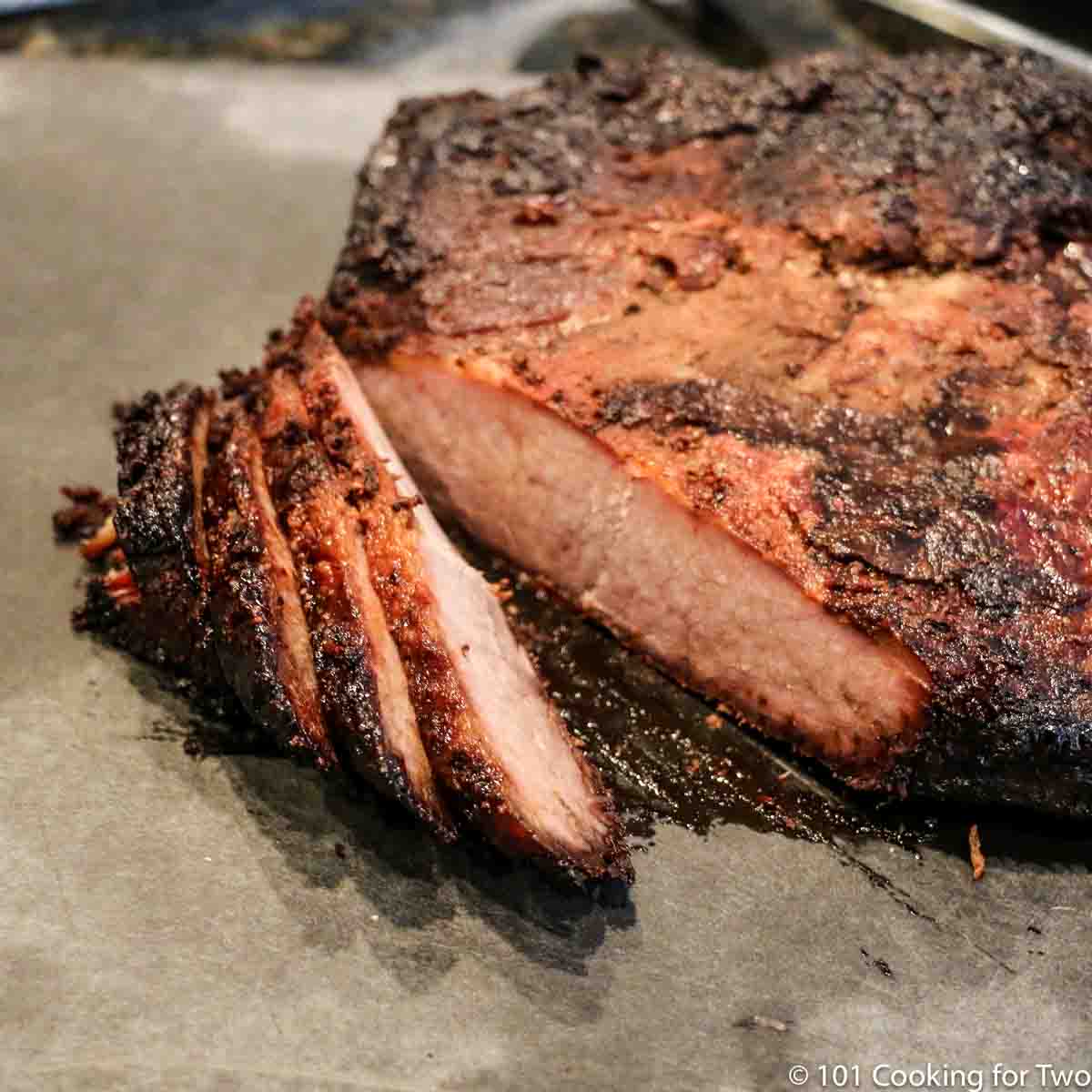
Jump To (scroll for more)
- 🐄Ingredients
- 👨🍳How to Cook Brisket on a Gas Grill—Step-by-Step Photo Instructions
- ⏰How Long to Grill a Brisket
- 🌡️When is Brisket Done?
- 🌡️What Grill Temperature to Use
- 📚Reference posts for more information
- ✔️Tips to get it right every time
- What is "The Stall"?
- The Texas Crutch
- ❄️Storage and reheating leftovers
- ✔️FAQs
- Classic Grill Recipes
- 🐄About Brisket
- 👨🍳Recipe

Featured Comment from Matt :
"Thanks, this technique and explanation is fantastic! Haven't done it for a few years and these instructions are great."
⭐⭐⭐⭐⭐
BBQ brisket is the king of all barbecues. You can argue for pulled pork butt or baby back rubs, but it is smoked brisket for me. This brisket recipe provides what you need to make great brisket on your home gas grill. But you can use a charcoal or pellet grill.
Once you have your grill set up for low-and-slow cooking and smoking, it is easy to grill and smoke brisket on your gas grill with the easy step-by-step photo instructions.
👨🍳How to Cook Brisket on a Gas Grill—Step-by-Step Photo Instructions
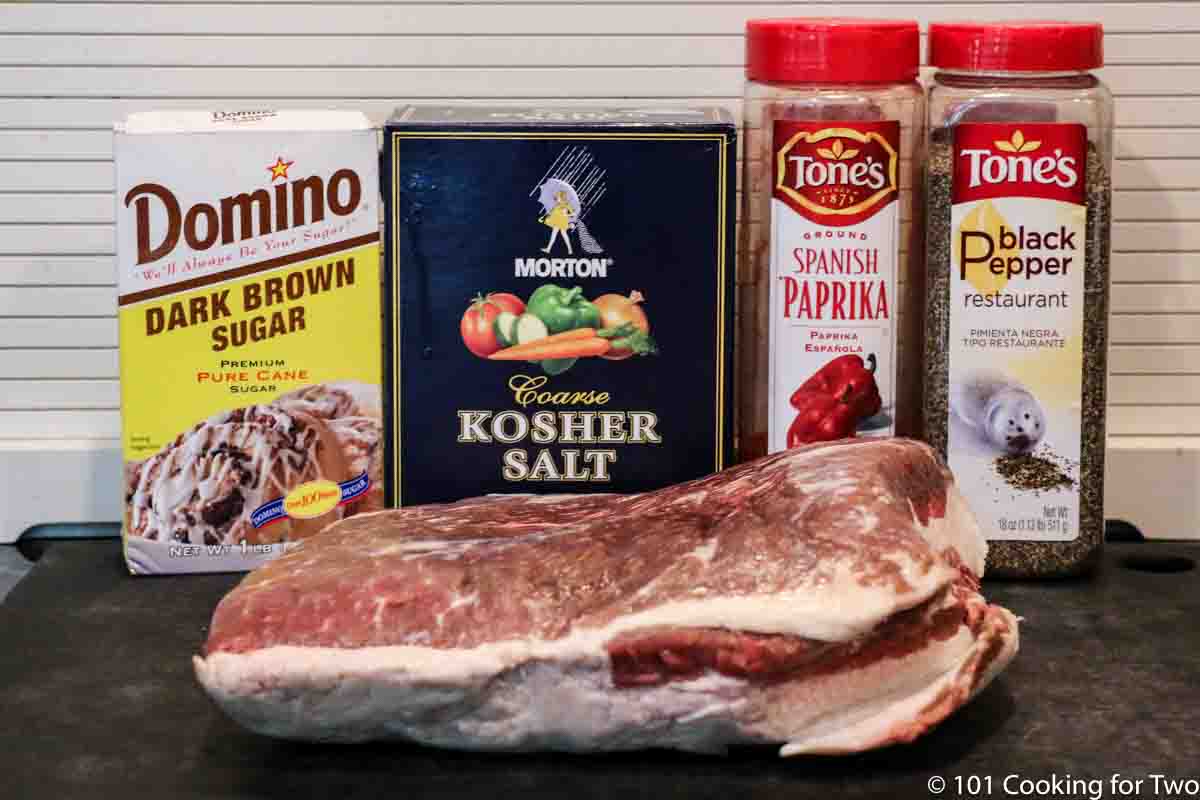
1. Use a half or whole brisket and rub of your choice.
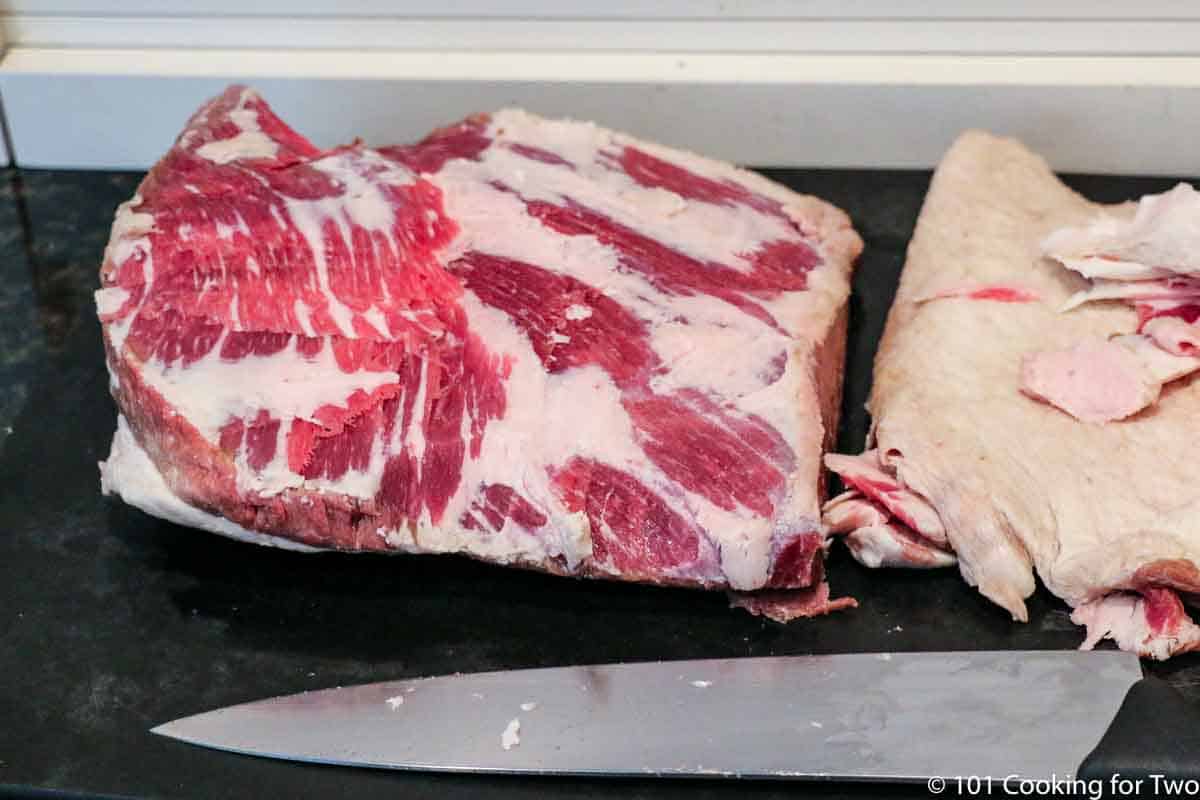
2. Optional: Trim brisket of large chunks of fat and the fat cap.
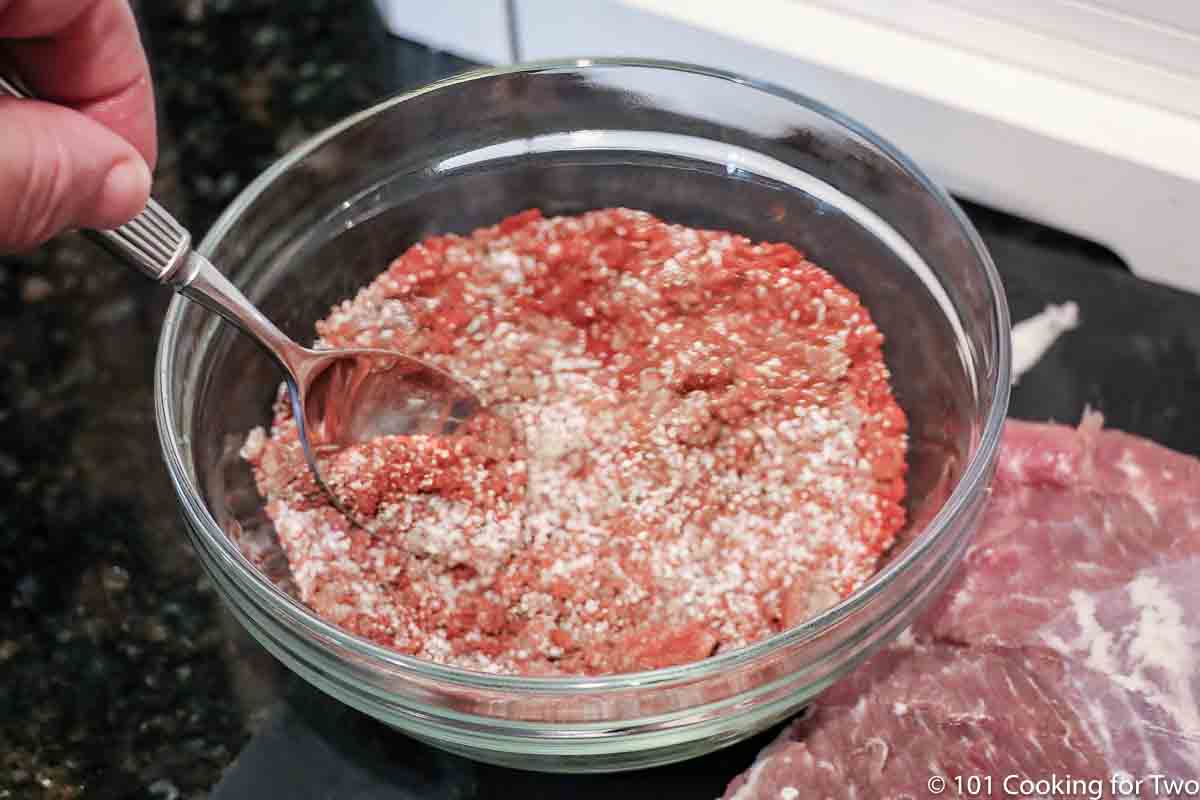
3. Use the rub of your choice, or you may use mine.
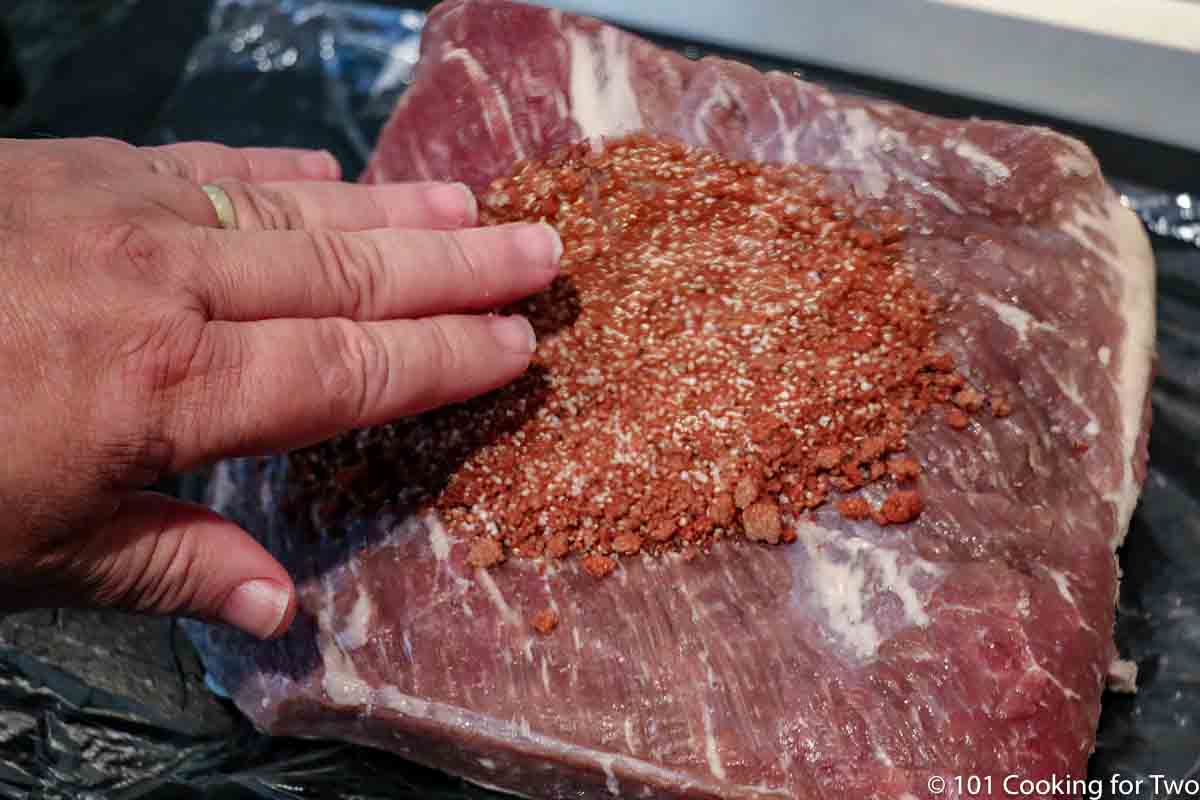
4. Give all sides of the brisket a heavy coat of rub.
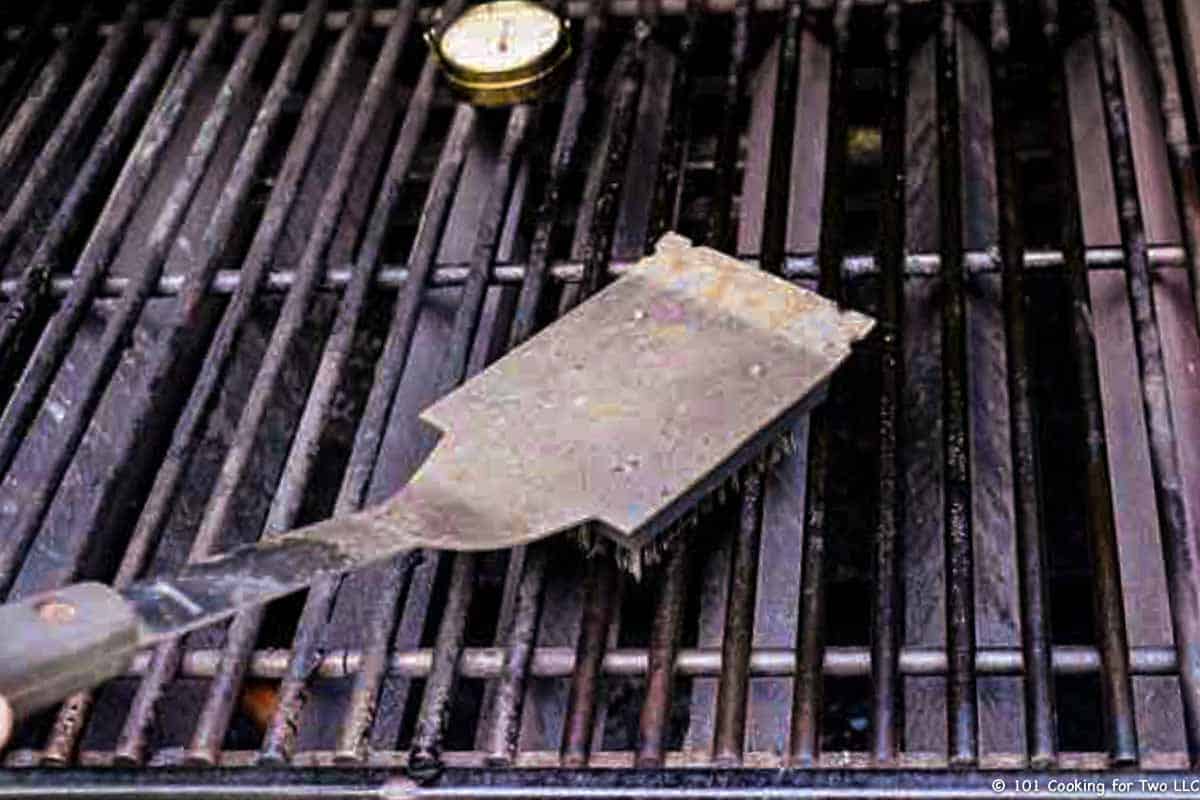
5. Set up the grill for a steady temperature of about 225°-250° with indirect heat, a drip pan on the indirect side, and a way to create smoke.
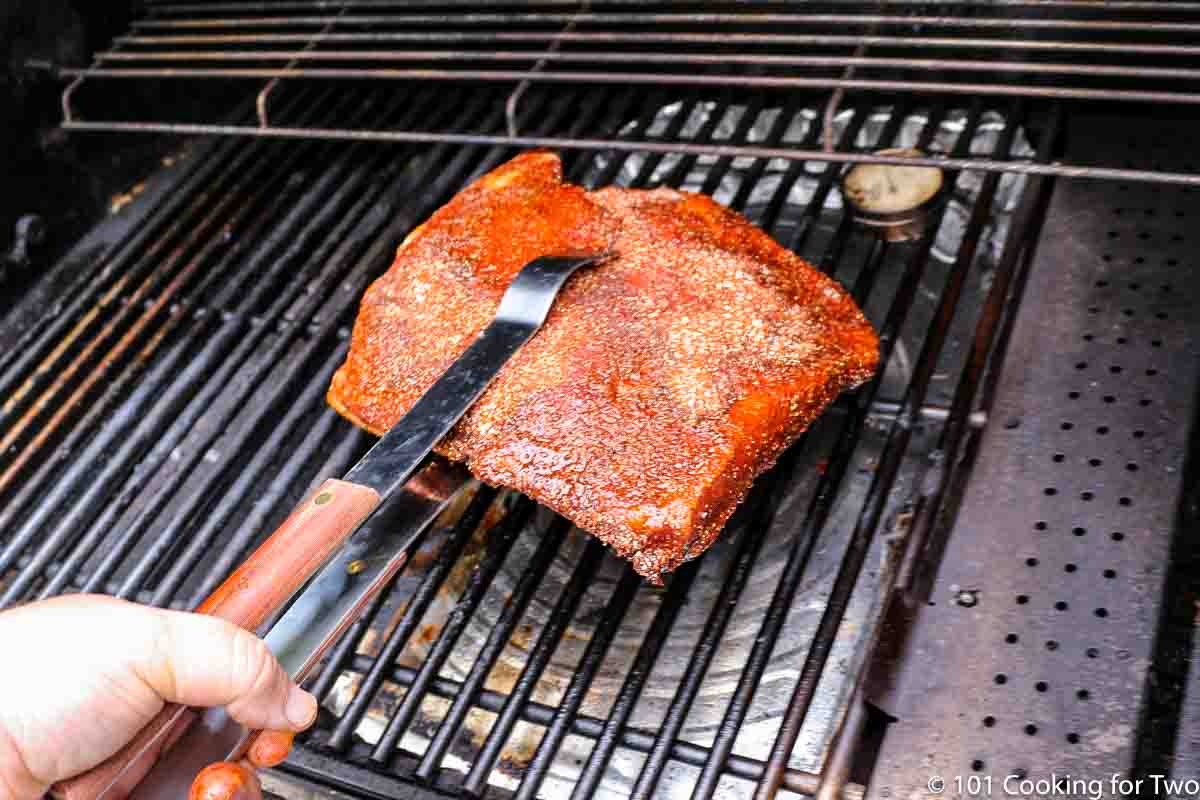
6. Cook on the indirect side over a drip pan.
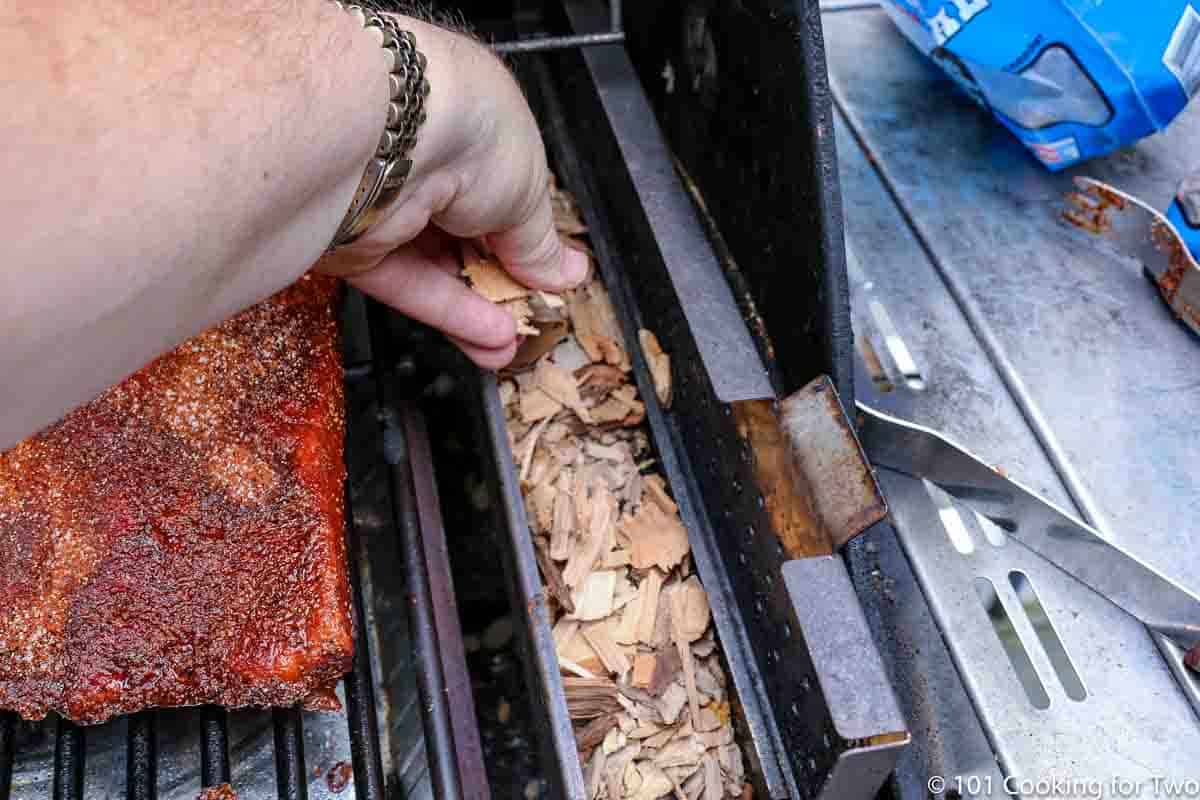
7. Add smoke.
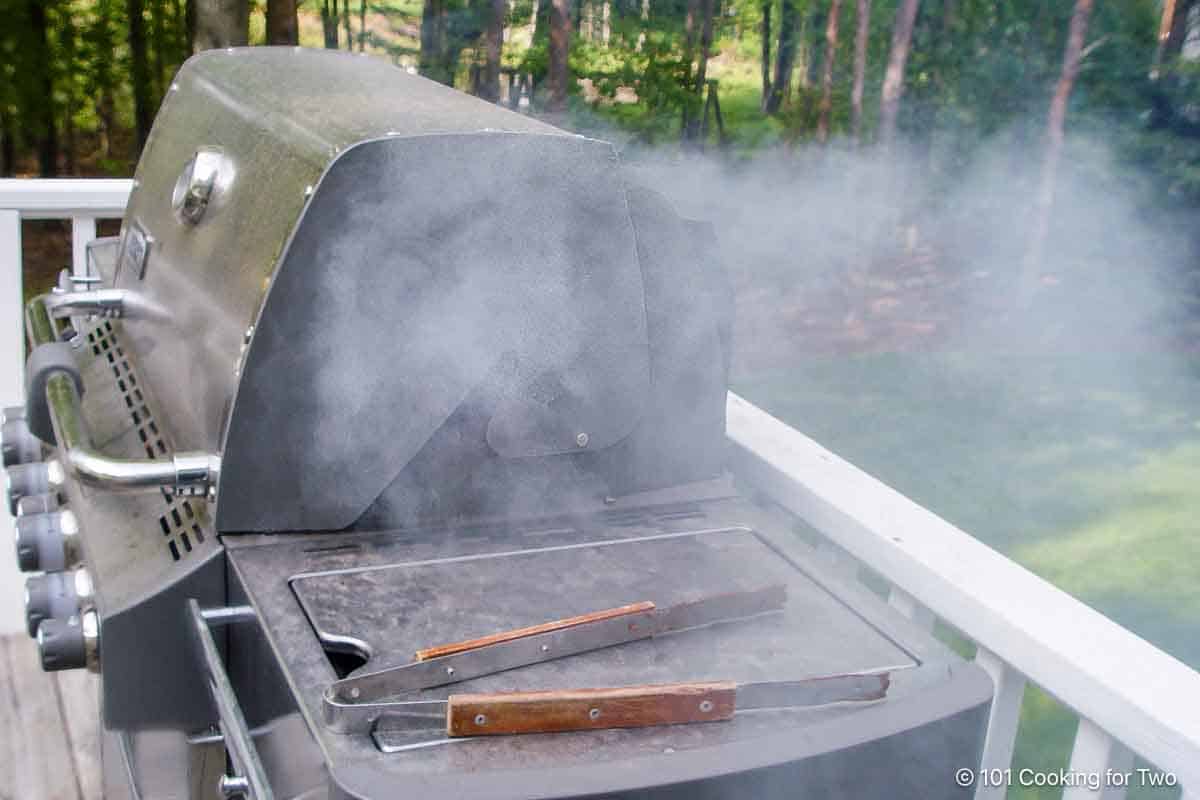
8. Cook until an internal temp of 200°-205°, about 5-6 hours total cooking time with the 5-pound point.
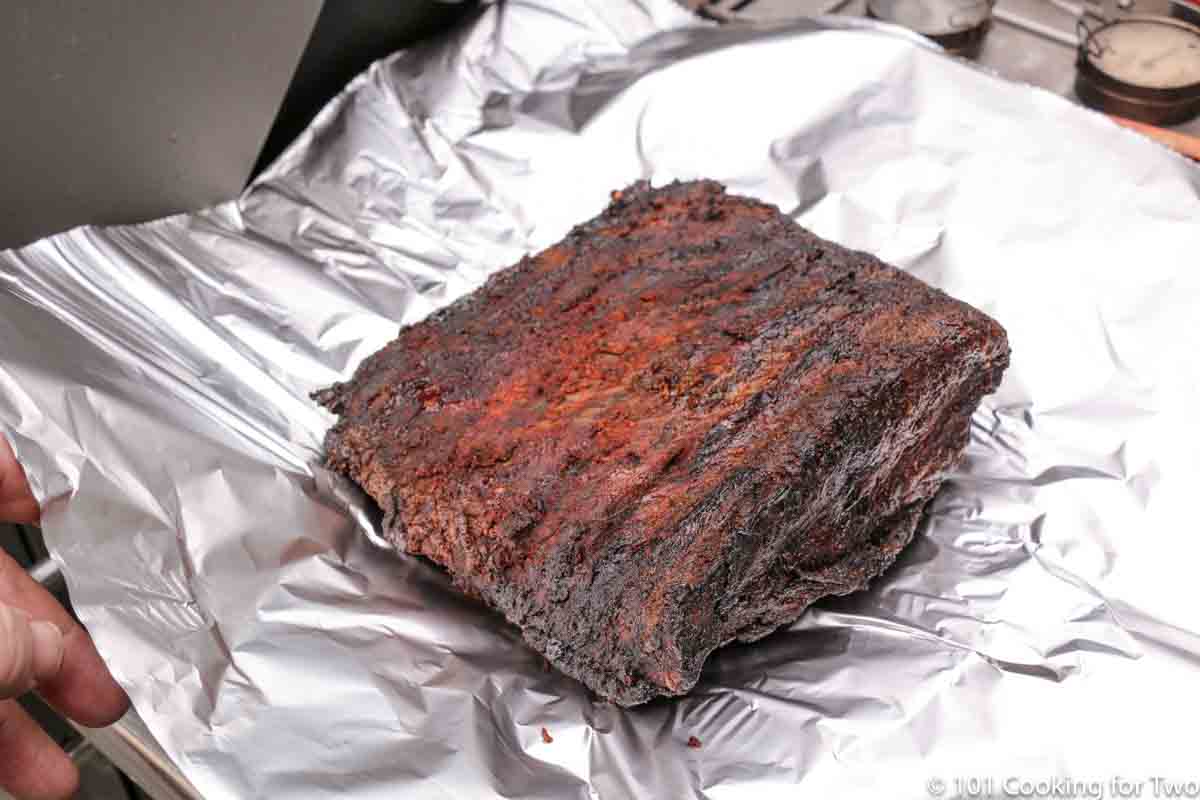
9. Remove from the grill and wrap in foil and a couple of towels.
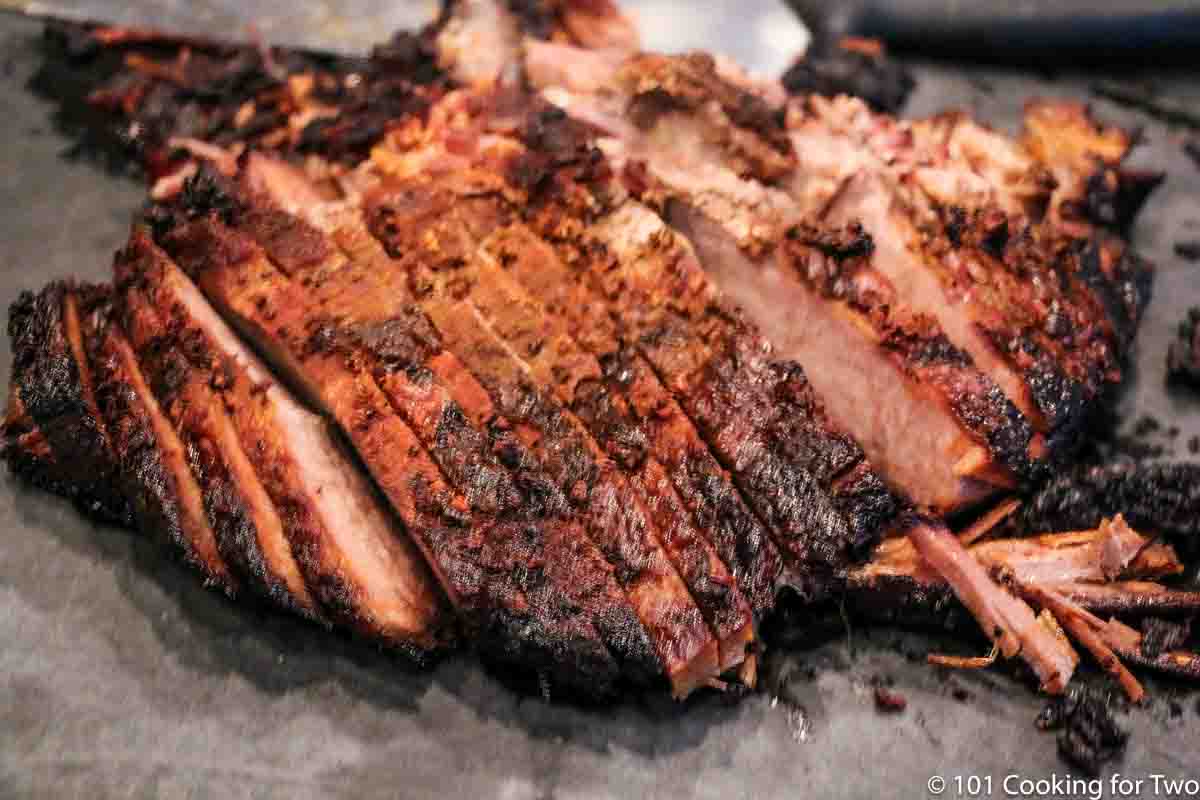
10. Allow to rest for 1-2 hours before cutting thin across the grain to serve.
For more details, keep reading. See the Recipe Card below for complete instructions and to print.
⏰How Long to Grill a Brisket
Most will say 1 to 1 ½ hours per pound, assuming a 250° grill. It is not a bad starting point for time management, but a wide range. The significant variables are weight, thickness, and grill temperature.
🌡️When is Brisket Done?
Brisket is done when the internal temperature reaches 200°F-205°F. I think 190°F is too low. 195°F-200°F will slice nicely. But 203° seems to be the number competition smokers want. 205°-210° is ok. But over 210° is probably too much and will become a texture and moisture issue.
🌡️What Grill Temperature to Use
Try to use a stable grill surface temperature of 250° in the indirect heat area. Most smokers will use 225°. As you get to 300°, you will get more dryness issues.
You must have a good grill surface thermometer to do this correctly. A continuous read probe meat thermometer is a good idea, along with the required surface thermometer.
These are products I own and use. All product links are affiliate links—see the Privacy Policy for more information.
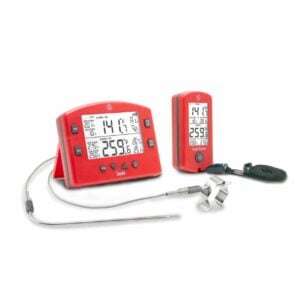
Smoke™ by Thermoworks™
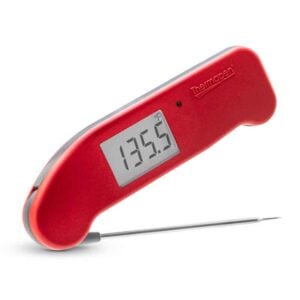
Thermapen™ One from Thermoworks™
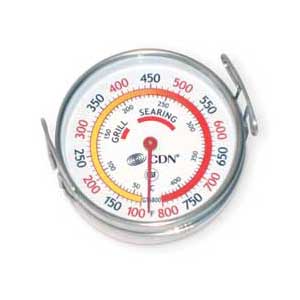
CDN Grill Surface Thermometer
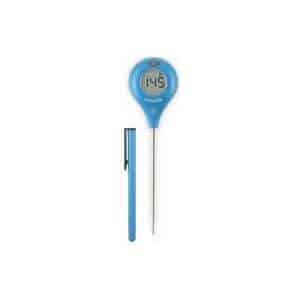
Thermopop™ by Thermoworks™
📚Reference posts for more information
- How To Set Up Your Gas Grill for Smoking and Low and Slow Cooking
- A Beginners Guide to Grill Temperature on a Gas Grill
- BBQ Dry Rub
- Memphis BBQ Sauce—Sweet and Tangy
Easiest Oven Baked BBQ Beef Brisket
Learn how simple it is to make smoky and tender oven-baked BBQ Beef Brisket with this never-fake brisket recipe—just two ingredients and 5 minutes of prep time—everybody deserves great BBQ.
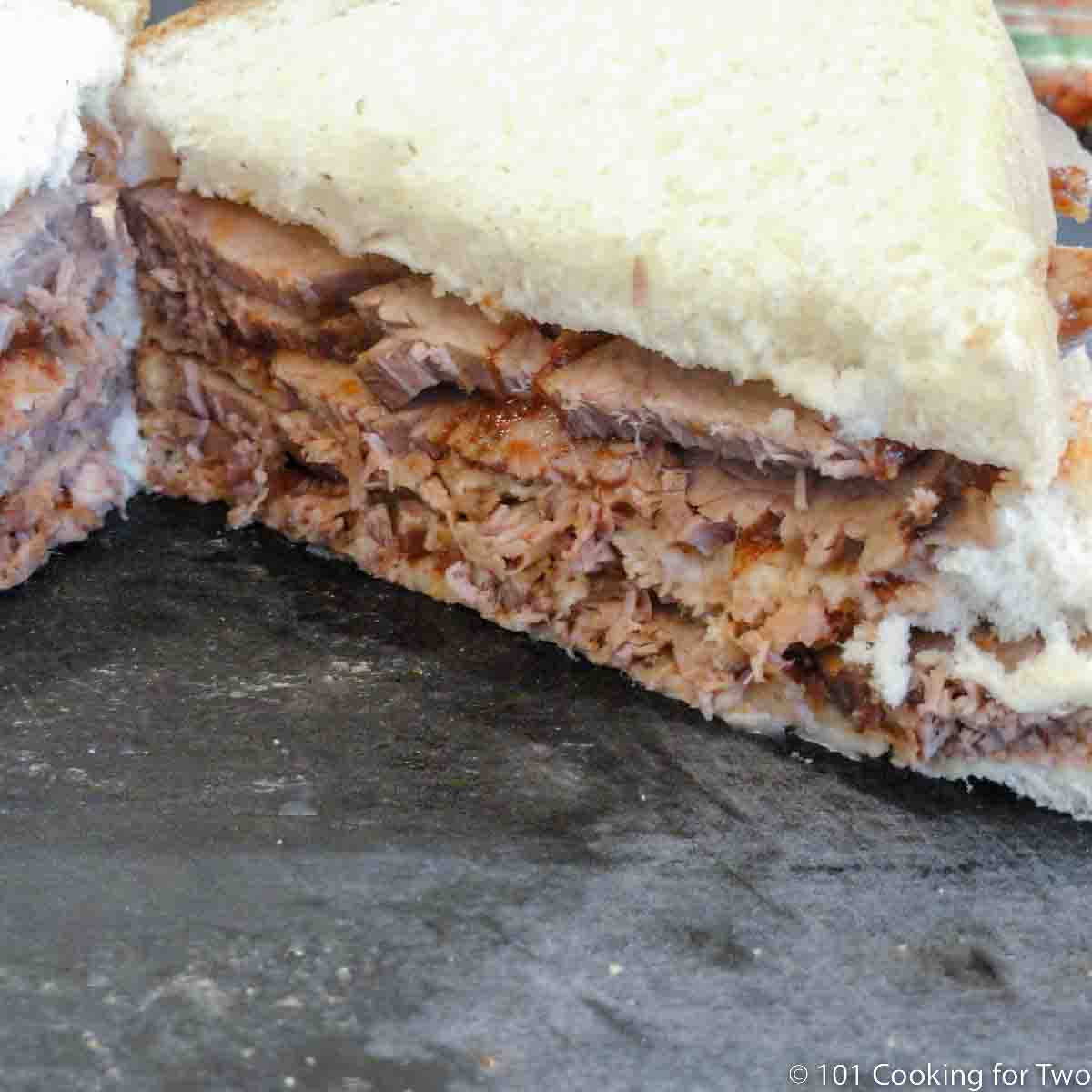
✔️Tips to get it right every time
- Use the grill you have, but it needs to be big enough for the meat and the cooking technique.
- You can use a charcoal or pellet grill if you can control the temperature.
- Be sure to have enough fuel to complete the cooking—an extra tank of propane, an extra bag of wood pellets, or charcoal. I use a natural gas grill.
- This recipe only has the most basic dry rub, but it works and is delicious. But for a more complicated flavor profile, check out my full BBQ Dry Rub with infinite options.
- Fat side up or fat side down is hotly debated, but it does not matter. The moisture is from the melted connective tissue and not the fat. My friendly competition smokers agree. It does not matter. I prefer to trim some to decrease the mess and increase the surface area for great bark.
What is "The Stall"?
“The Stall” happens when the fibers of the meat contract nearing 150°F to 160°F. This occurs with both beef and pork and continues to about 180°F when the meat fibers start to relax.
Since it occurs past "well done" temperature for most meats, it is not an issue for steaks, pork chops, or similar cooking. But with brisket or pork butt, where we are cooking to the 200° plus range, you may want to consider this issue.
The water in the meat fibers will be forced out of the cells as they contract and will make their way to the surface. On the surface, the water will evaporate as cooking continues. Evaporation uses energy and will “stall” the cooking process.
This stall can go on for hours, depending on the size of the meat and other factors. Six hours sometimes for a large whole brisket.
The Texas Crutch
The "Texas Crutch" is used to counter “the stall.” It is tightly wrapping the meat to prevent evaporation. 90% of competition smokers do this. But remember, they are cooking large whole briskets.
By tightly wrapping, you are creating a “mini-environment” next to the meat, which will quickly reach 100% relative humidity and prevent further evaporation.
While the meat fiber will continue to contract and force out water, it can not evaporate, cooling your meat and prolonging the cooking time.
Pros and Cons of “The Texas Crunch”
Pros
- The biggest pro is time. You can save hours in cooking time, especially with larger cuts.
- Moisture. It can help maintain moisture in the meat. As the beef passes the 180° range and the cells relax, the moisture can re-absorb into the cells. This is not a huge effect.
- If on a smoker, you can also control smoke exposure.
Cons
- The main con is water can destroy your bark. Your hard-earned crunchy bark becomes soft. You can counter this some (not completely). See the next section.
- The fussiness and a bit of work. Yep, some people complain about anything.
- Your grill temp goes down. I work hard to keep my temperature stable. I try to keep my hands off and the hood closed as much as possible.
The Technique of the Texas Crunch
While some will use butcher paper (the pink butcher paper, not the white wax-coated stuff), I don’t want to buy hundreds of feet of it. It may be a bit better on the bark issue. Most people use heavy-duty aluminum foil since we all have that.
- You will want to do this in the 150°-160° range when the meat temperature “stalls.” Also, the bark should be dark red approaching black and “set up,” meaning not mushy looking.
- Get an area close to the grill and get two large pieces of foil ready to double wrap.
- Quickly grab your meat off the grill. Do not just flip the lid wide open and keep it that way. Open as far as you need and close immediately.
- Wrap tight. I will say that again, TIGHT and crimp the seams and ends. The less space in your mini-environment, the better.
- Crimp tightly around your meat thermometer. You must have a continuous read thermometer to do this right.
- Back to the grill until you reach your goal temperature, usually 200°-205° for me.
- If you want to improve your bark, unwrap at this point and cook for 30 more minutes.
Why I don’t usually do this.
- I’m cooking smaller pieces of meat—less stall. So, there's not much reason to bother with it.
- I love a good crunchy bark. If you don't care about bark, do my oven method.
- The moisture thing is not that much. A lot of that “moisture” you love is melted collagen. Collagen melting starts at 160° and increases to 180°.
❄️Storage and reheating leftovers
Store leftovers in an airtight container and refrigerate for 4 days. Or freeze for 3 months.
Reheat covered in a 300° oven until hot. While I yell and scream about using sauce to reheat pulled pork, brisket can take the abuse from the acid in the sauce, so it's your choice.
✔️FAQs
Buy ½ pound per person. For teenage boys, assume 1 to 1 ½ pounds. Plus, you want leftovers.
The anti-trimming gang says it is natural and will protect the meat.
The trimmers will argue it makes a big mess and that it is the melting of collagen that produces most of the moisture. Also, more area for the rub to be on the meat.
A compromise is to trim the layer of fat to ¼ inch thick. This is usually what I do now, but the picture is a full trim. I'm not eating a chunk of fat just because it has the "bark" on it. But tender brisket with bark is heaven.
Injecting brisket—I don't. You can add a variety of flavors, but I don't want to do that—I want my brisket to taste like brisket, not apple juice or something else.
Is it moister with injecting? Some say yes, and some say no. If yes, then it is marginal. Research injecting carefully before doing this. Mistakes can ruin your brisket.
Brining brisket—Some people swear by it, but most competition smokers don't. I have never been a fan of brining beef. I have experimented with other cuts of beef, and I felt it took away the "beef" flavor a bit.
This is a personal taste thing. I love hickory, but mesquite, apple, cherry, and pecan are good for smoking a brisket. Oak seems to be another commonly suggested wood, but it would be my last choice.
Yes, as long as you can maintain the grill temperature correctly.
Classic Grill Recipes
Don't miss these classic grill recipes, like Smoked Pulled Pork and Baby Back Ribs on a Gas Grill. And use my wonderful Memphis Barbecue Sauce.
🐄About Brisket
Beef brisket is a cut of meat from the lower chest wall. The brisket includes superficial and deep pectoral muscles, which have lots of connective tissue. The cow does not have collar bones, so these muscles support about 60% of the body weight of the 1500-pound cow.
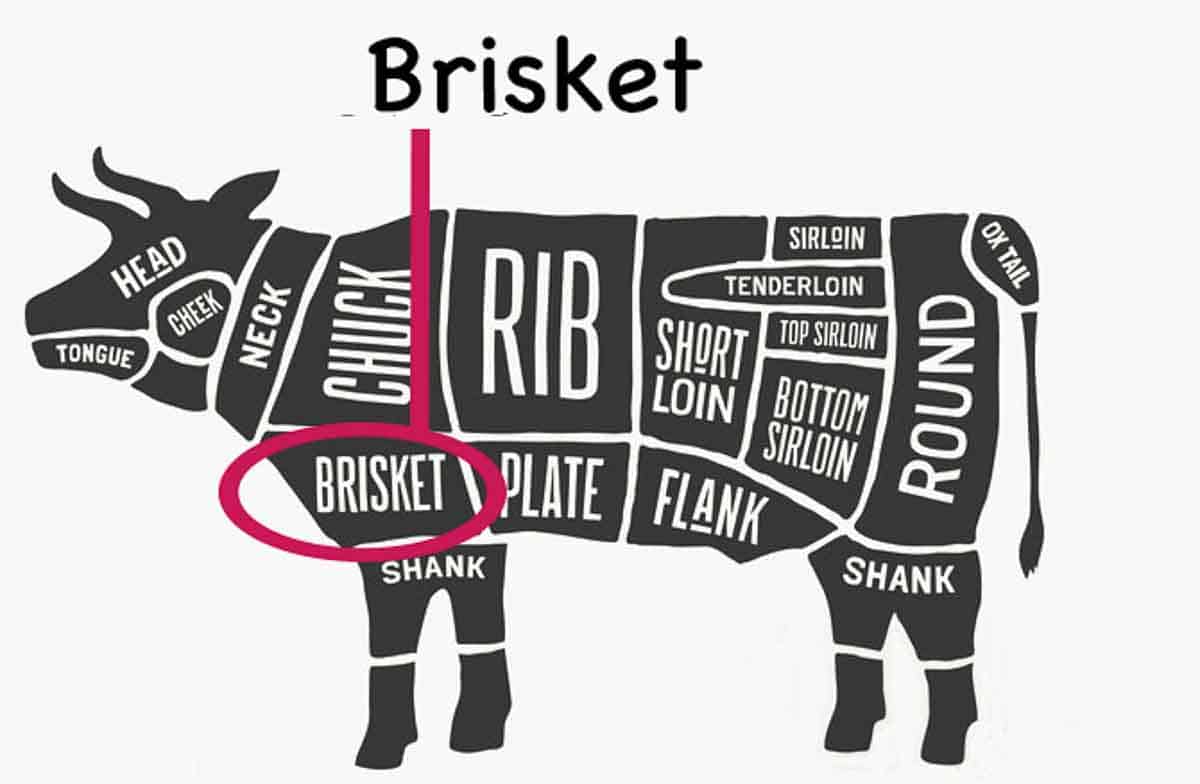
Whole briskets are generally vacuum packed for the producers and are usually 8 to 12 pounds, which is more meat than most of us “cooking for two” people want except for parties.
Many consumer meat markets and some grocery stores will sell half briskets. There are the “point” and “flat” halves. Generally, the flat half has two layers, and the point has only one muscle layer.
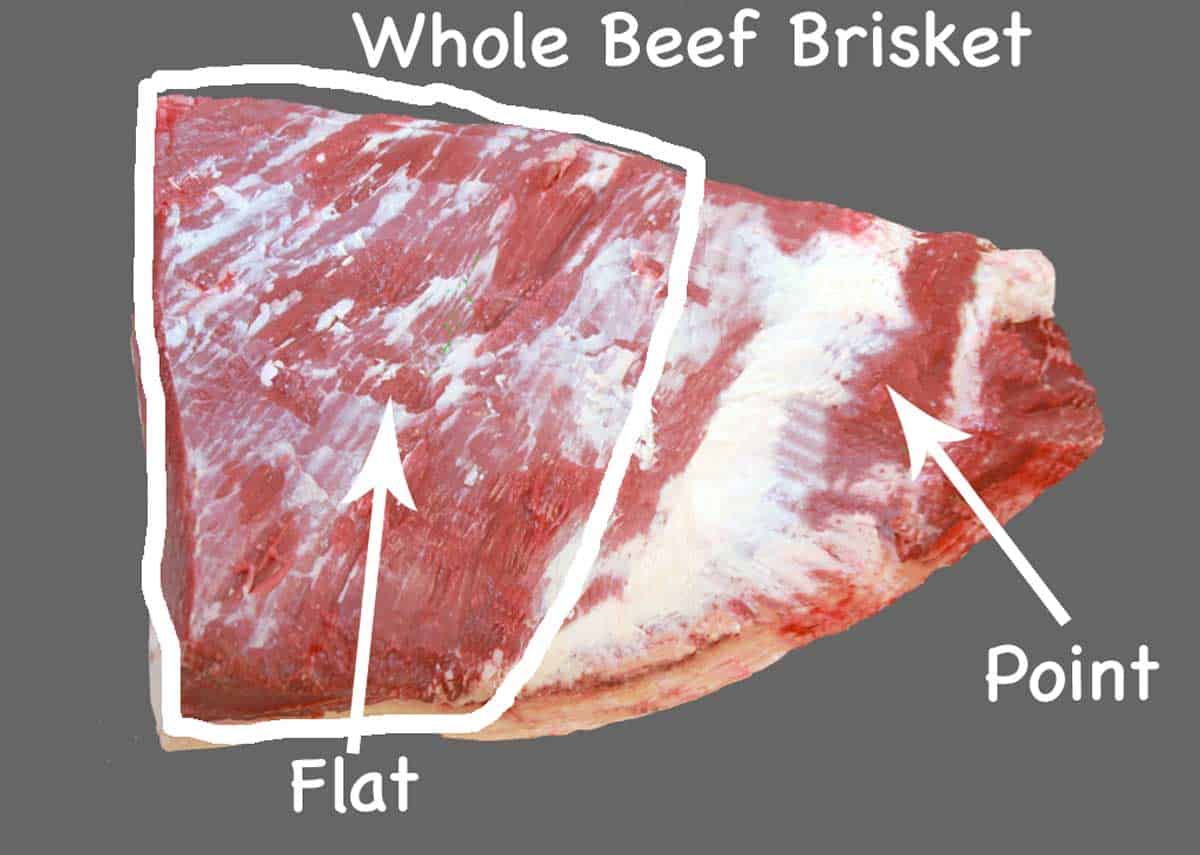

👨🍳Recipe
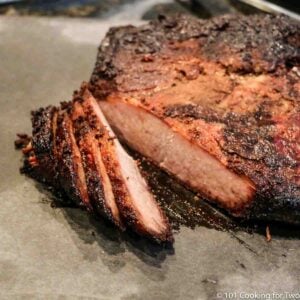
How to Cook a Brisket on a Gas Grill
Save this recipe to your inbox for later!
You may recieve the email without subscribing if you wish, but the subscription is convienent and has an easy one-ckick unsubscribe.
Ingredients
- 5 pound Brisket - Size of your choice
My rub for a 5-pound brisket. Scale for different size. You may use the rub of your choice.
- ¼ cup brown sugar
- ¼ cup paprika
- 2 tablespoons kosher salt
- 2 tablespoons black pepper
Instructions
- Use a half or whole brisket and rub of your choice.
- Optional: Trim brisket of large chunks of fat and the fat cap. Don't try to be perfect. Some people don't trim or will leave a ¼ inch thick layer. Personal choice.
- Use the rub of your choice, or you may use mine. For my rub, mix rub of ¼ cup each of brown sugar and paprika. Add two tablespoons each of kosher salt and black pepper and mix well.
- Give all sides of the brisket a heavy coat of rub. Wrap with plastic wrap and refrigerate for a few hours or overnight if you have time, but rub and go works. Remove from refrigeration about 1 hour before cooking and allow to rest at room temperature.
- While the brisket is resting, set up the grill. You want a steady temperature of about 225°-250° with indirect heat, a drip pan on the indirect side, and a way to create smoke. See the link in the post for more information.
- Cook on the indirect side over a drip pan.
- You need a method of adding some smoke to your brisket. The method, amount, and duration are up to you. I do about 1 hour of hickory with my built-in smoke box. But foil packs or cast-iron smoker boxes work well. Set How To Set Up Your Gas Grill for Smoking and Low and Slow Cooking.
- Cook until internal temp of 200°-205°. It takes me about 5-6 hours total cooking time with the 5-pound point.
- Remove from grill and wrap in foil and a couple of towels.
- Allow to rest for 1-2 hours before cutting thin across the grain to serve. If you have a flat half or whole brisket, separating the layers before cutting is best.
Recipe Notes
Pro Tips
- The set up of the grill for low and slow cooking plus smoking is the most important part of cooking a brisket on a gas grill.
- Use the rub of your choice, but I include a suggested rub.
- I usually will do smoke for about an hour, but more is fine.
- Cooking time varies a lot, but 1-1 ½ hours per pound is a good starting point to estimate your cooking time.
- Be sure to wrap and let sit after cooking for 1-2 hours.
- You must cut across the grain.
- See the write-up about injection, brine, the stall, and the Texas crutch.
- For serving size by the person. Cook ½ pound per person but double or triple for teenage boys. And you want leftovers.
- This recipe scales up well, but a large whole brisket may take 12-16 hours, and you want to read my discussion about the Texas crutch in the main post above.
- Good in refrigerator for 3-4 days and freezer for 3-4 months.
- Please see How to Set Up a Gas Grill for Smoking and A Beginners Guide to Grill Temperature on a Gas Grill for low and slow grill setup instructions if you need help.
Your Own Private Notes
To adjust the recipe size:
You may adjust the number of servings in this recipe card under servings. This does the math for the ingredients for you. BUT it does NOT adjust the text of the instructions. So you need to do that yourself.
Nutrition Estimate
© 101 Cooking for Two, LLC. All content and photographs are copyright protected by us or our vendors. While we appreciate your sharing our recipes, please realize copying, pasting, or duplicating full recipes to any social media, website, or electronic/printed media is strictly prohibited and a violation of our copyrights.
Editor's Note: Originally Published July 28, 2014. Updated with expanded options, refreshed photos, and a table of contents to help navigation.
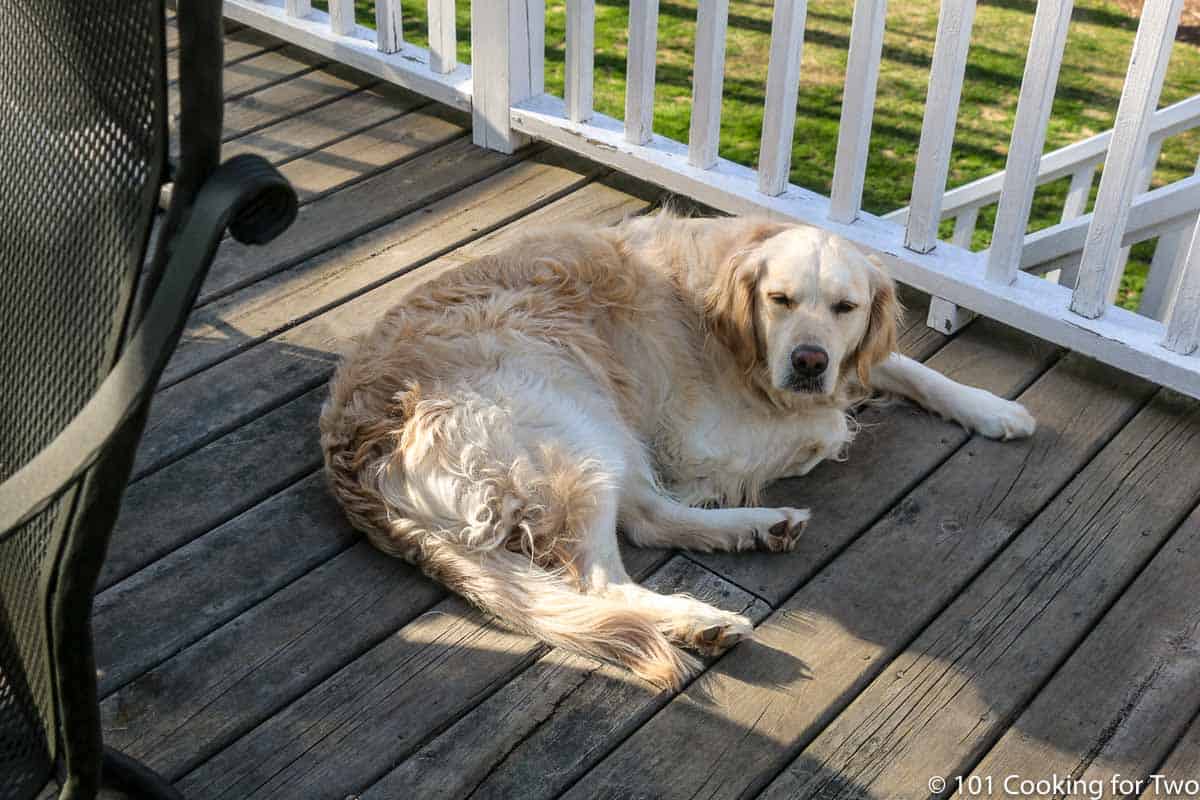


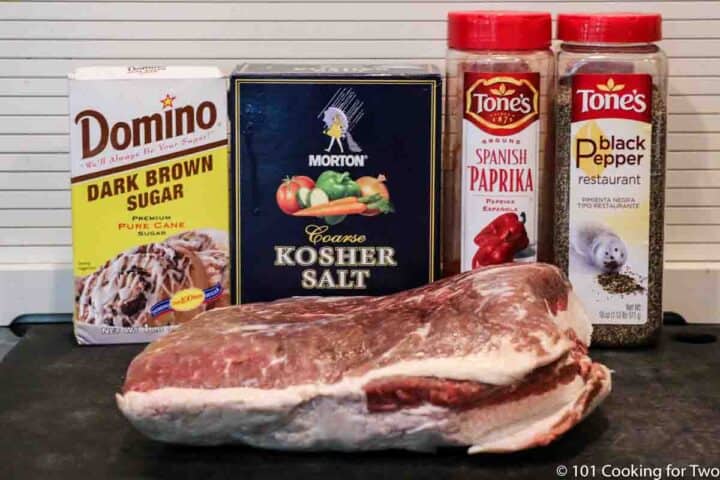
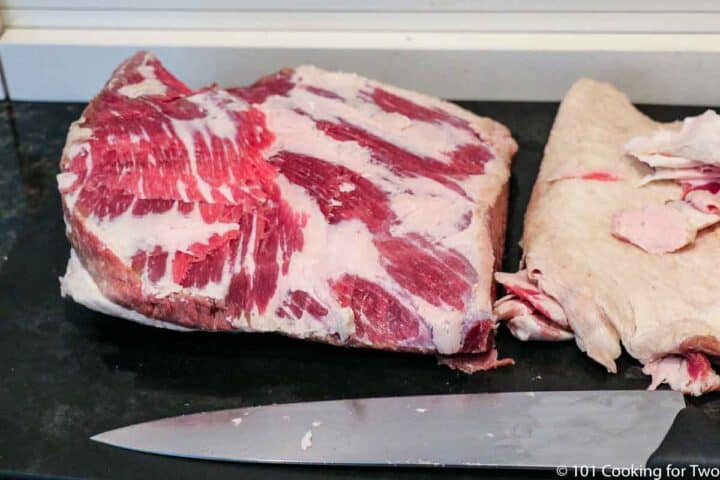
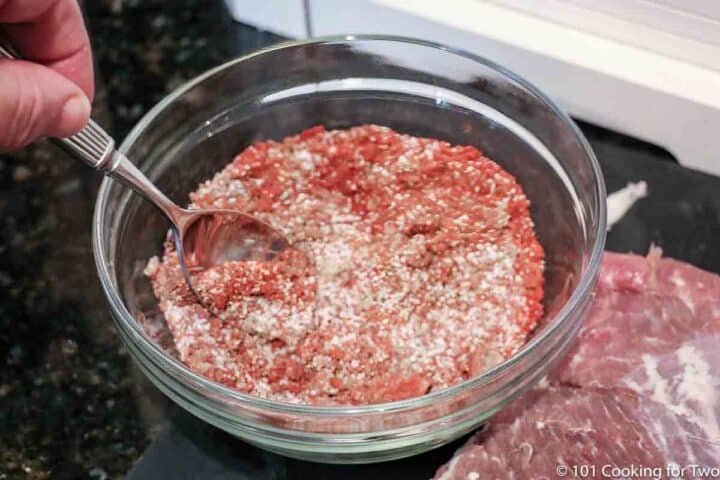
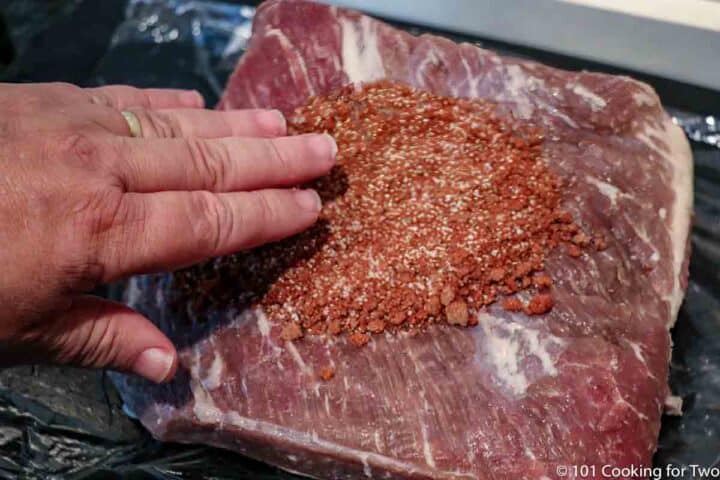
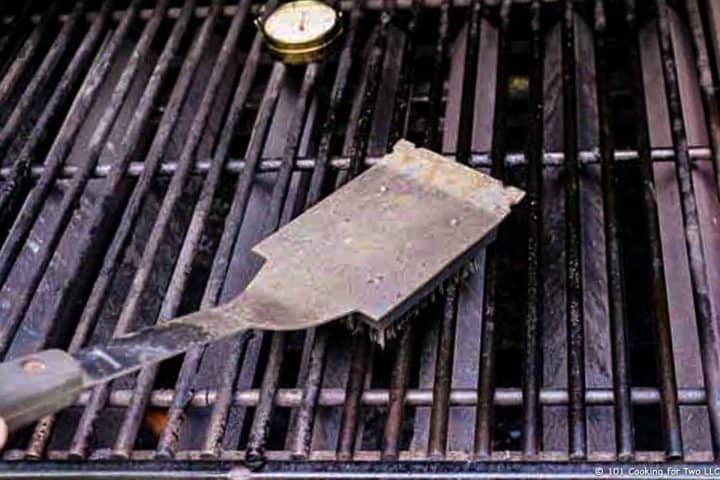
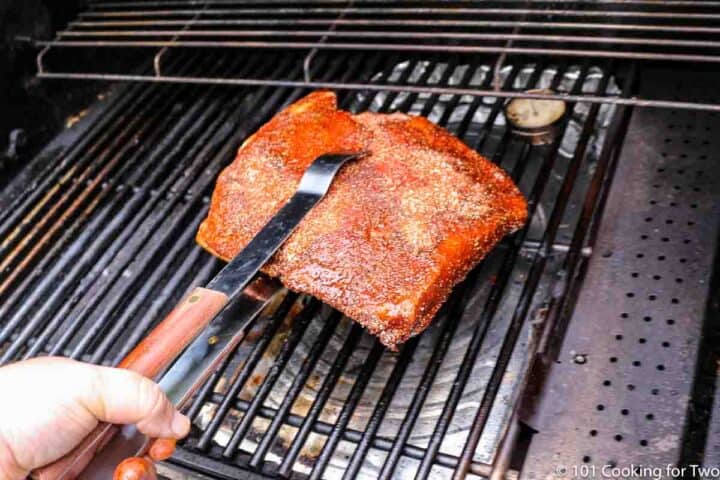
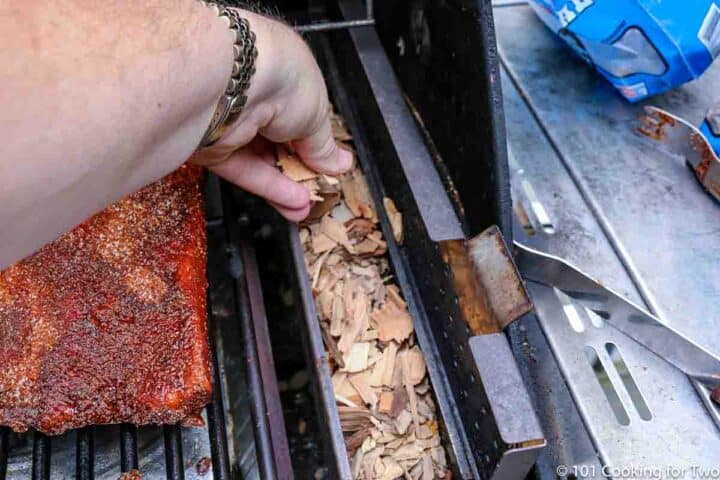
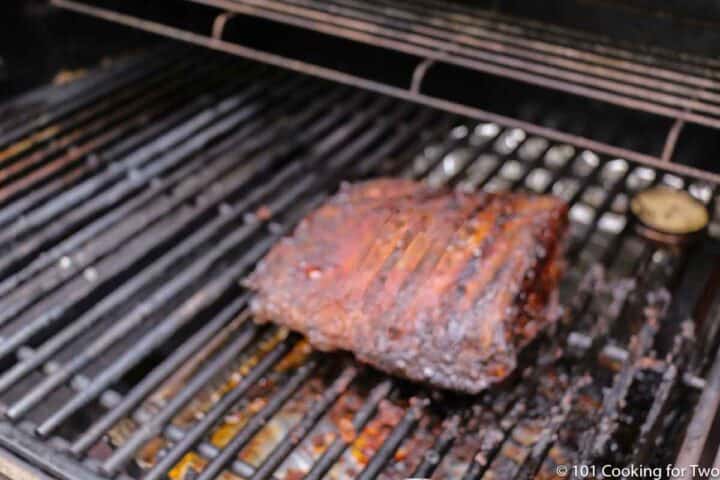
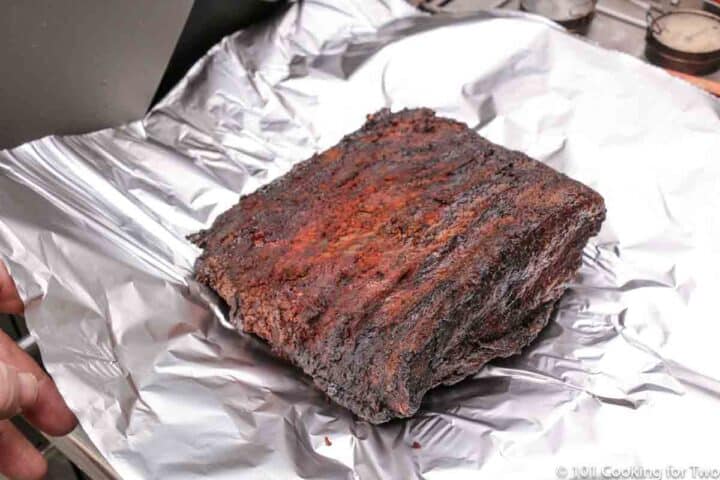
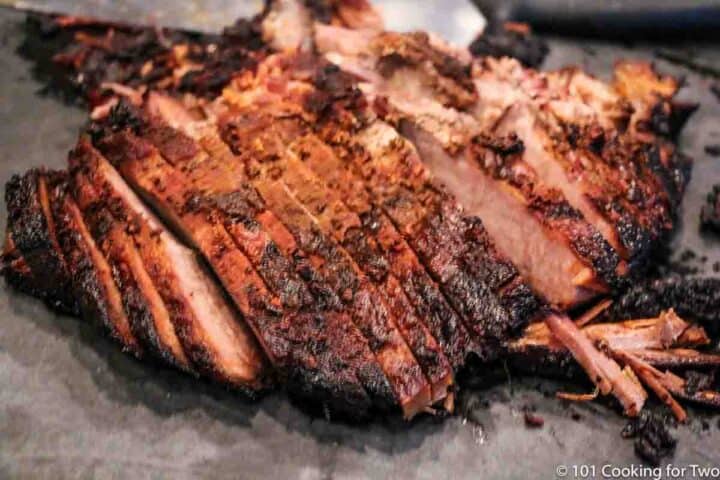
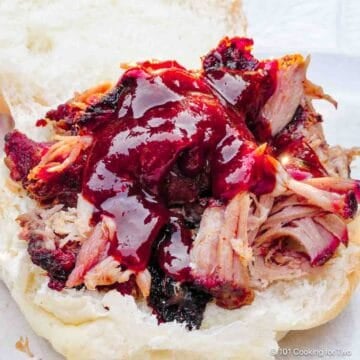
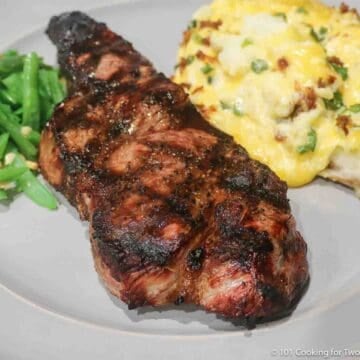
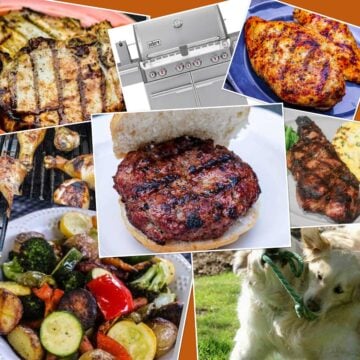
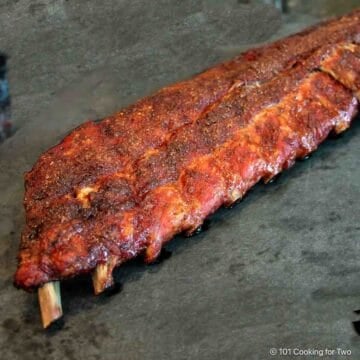
Mitch says
you have point and flat backwards in the photo
Dan Mikesell AKA DrDan says
Hi Mitch,
It almost looks like it but that is a large point. The point is a fattier part and if you buy a "point" it will generally have a layer of flat with it. I have never seen it sold separated but it would be more correct to me.
Dan
Andy C says
I do about 1 hour of hickory with my built-in smoke box...
So, you only keep the wood chips in the box, in the grill, smoking for 1 hour?
I thought the idea was to smoke it continously during the entire cook.
Could you clarify: how much smoke time is ideal (for a 5 lb brisket)?
Dan Mikesell AKA DrDan says
Hi Andy,
Welcome to the blog.
I generally smoke for an hour or two at most. That gives a lot of smoke flavor. It would be hard to do much more on a gas grill since you will need to keep opening the lid and I don't see it as needed.
Dan
Jim Green says
My goodness!! It’s a piece of meat. I was raised on a farm where we slaughtered our own beef, hogs, etc. and we didn’t have fancy grills like we have today- so you have to use a little common sense. My mom could cook this on a wood fired Home Comfort Range. I am lucky I am using a Beef Eater natural gas grill with all the bells and whistles. I really do like the recipe and a meat thermometer is a necessity! Cheers.
David says
You mentioned to smoke for an hour. Is this at the beginning or at the end?
Dan Mikesell AKA DrDan says
Hi David,
Welcome to the blog.
I do it near the beginning. The amount of smoke is more of a personal taste. I find an hour or a bit more is enough for me. 2 hours is pushing it. One local smoker (with a restaurant) smokes the entire time. Way too much smoke for me.
Also, if you decide to do the Texas crunch for the stall, it would obviously block smoke.
Hope that helps and feel free to ask if you have other questions.
Dan
John Vaughan says
Hi Barry. Thanks for this. Great post! I’ve been searching all over for a brisket recipe to do in my bbq for my family. I now have a 2kg “flat” angus and will give it a burl tomorrow. Just a quick request, and I know I could do the conversions, but would you be able to do a quick edit of the key weights and temperatures to give us metric users a feel for what your talking about? For example, a 5 pound brisket is about 2.2kg, the key temperature of 225-250F would be 110-110C. It’d make reading it so much easier for the rest of the world! Cheers mate, John
Brisket says
Degrees what? C or F?
Dan Mikesell AKA DrDan says
American blog so all temperatures are Fahrenheit, not Celsius. I lived in both worlds in medicine for 40 years, patients talked in F and we talked to each other in C but then back to patients in F. I got very good at conversion.
Dan
Al says
Hi Dr Dan
I'm wondering what you would think of parchment paper as a simple substitute for butcher paper.
Thanks for sharing this. Will be trying it (very) soon.
Kindly,
Dan Mikesell AKA DrDan says
Hi Al,
Welcome to the blog.
I have heard of it but never used it. The issues with it are it doesn't "breath" (let some mosture through so the bark is not as good), and it is thinner and not as wide (so it harder to use). While some will use it routinely, most seem to use it only in an emergency. Do some Googling for a variety of opinions.
Dan
Downtowndad says
Thank you so much for the guidance. I did a 10# brisket on my Weber Summit using indirect heat from the side burners at around 250 on a half-sheet pan with a grate. I put a water/cider vinegar 1:1 mix in the pan.
One thing that I don't recall seeing in the instructions: FAT SIDE DOWN. Otherwise, no bark will form. You can, theoretically, start with fat up and then flip at some point "halfway."
I used your salt:pepper ratio, which I found too peppery for my taste (to each their own!) Next time, I will do a 2:1:1 (salt:pepper:granulated garlic).
I did NOT use any smoke. Just rub. It still was fantastic.
Took about 10 hours. The stall at 160 lasted about 3 hours.
That is definitely something that will give a person a false sense of security - you'll get to 140/150 in not-too-long, then at 160, it'll suddenly stall. Of course, it's to be expected. Just ride it out and trust your thermometer (as long as you can trust it.) If you start opening the grill to check on it, you'll lose heat.
The good think for me is that, when I did add water/vinegar to the pan, I was able to lightly increase the heat to get the temp back to 250.
Ronni says
Dan,
I used this recipe on Thanksgiving with an Angus flat and used smoked paprika. It took about 1.5 hours per pound and everybody loved it!! I used a 3-burner Weber Genesis grill with hickory chips. I did my best to keep the heat at or below 250, adding a handful of chips about every 30 minutes and flipping the meat every 2 hours. Thanks for a great recipe!
Josh says
Thanks for posting this. You mentioned to set up the grill for smoking. I have a simple 4-burner propane grill. I don't see a smoking option. I can get the temp right for slow cooking and can heat it directly or indirectly. Is there some way I can generate smoke inside my grill to accomplish what you're recommending? What if I just put a wood chips in a metal bowl inside the grill? Would that do it?
Thanks in advance. Josh
Dan Mikesell AKA DrDan says
Hi Josh,
Welcome to the blog.
Grill set up and smoking options are linked in the post but you may have missed it. It is covered here. https://www.101cookingfortwo.com/set-gas-grill-smoking-low-slow-cooking/ Since it is relatively long and used for other recipes in addition to brisket.
Briefly, you can use a foil pouch with holes punched in it or get a cast iron smoking box discussed there. Place either over the hot burner.
Hope that helps.
Dan
TJ says
I love the smoke tubes for use with smoke pellets. I use 2 tubes for brisket.
JoyV says
DrDan.. this is my first try at brisket and am using your directions. One question though. Do I turn the meat or just leave it alone throughout the entire cooking process?
Dan Mikesell AKA DrDan says
Hi Joy,
Welcome to the blog.
No flipping is needed.
Dan
BARRY L PANITZ says
Man, I'm so glad I found your "101 Cooking for two" blog! But I need your help. Here's what I did: Set up everything as per your instructions on my Weber Spirit 2 gas grill. Did the smoker box--but never, ever got any smoke, dunno why. But, that's the first of my problems. I kept the heat as close as I could to your 225-250, and mostly between 240-250, which as I found was pretty hard on the Spirit 2-just a 1/16 inch dial turn would make huge jumps in heat output of my grill ( I had kept off the center and rightmost burners for indirect heat cooking, with the smoker box over the leftmost burner. The brisket was centered between the center and right burners. I reached an internal temp as measured by by Igrill2 thermometer, which backed down to 143. I was surprised by this as I didn't change anything. But, then,the internal temp stalled there for approximate 2 1/2 hours, in which time I was going crazy. Finally, it went to 146, then 148, and stayed there for another 1 1/2 hours. Slowly it went to 151, but this was after 6-7 hours of cooking. (Still, never had any smoke). I got really worried about the whole thing because it was taking entirely too long. I jacked the ambient temp to 260 and the temps started rising, but stalled again in the low 170's. I then jacked the ambient temp even higher to 300 and finally 315 just to get some internal temp movement. After 14 hours, 22 minutes, and these high ambient temps, I took it off at 195 internal temp. I was worn out, and dunno what the devil I did wrong--with the lack of any smoke and the complete stalls I incurred during cooking.
Anyway, we tasted the this morning after a 2 hour rest in towels and inside a cooler, then placed in fridge because it was then 2 am.
This morning, the taste was good, but uber dry. The recipe is pretty doggone good, but next time I'll tone down the salt.
Tell me where I went wrong, please.
Be well.
Barry
Dan Mikesell AKA DrDan says
Hi Barry,
Welcome to the blog and let’s see if we can shed some light on this.
I’m not directly familiar with your grill but it seems to have three burners front to back. The iGrill has probes for internal monitoring of the meat. There is an optional probe for air temp that clips to the grates (so a grill surface temperature thermometer.)
I will assume you when through my setup guide for the grill at https://www.101cookingfortwo.com/set-gas-grill-smoking-low-slow-cooking/.
So what could go wrong?
Mostly it is temperature and temperature measurement.
The smokebox not smoking seems odd, like it was not hot enough in that area. If it is over a hot burner, it should smoke. So either the hot burner is not very hot or the box is not directly over that burner. One other reason is that to smoke, there has to be the oxygen to be sure if you are using something like a foil pouch, it has enough vent holes punched in it. Wood would generally smoke even at 250-300.
The surface thermometer needs to be measuring the temp in the indirect area of the meat, not the burner that is on.
So check the placement of the air probe. It needs to be in the indirect area away from the direct burner. You might want to do a quick check of the surface temperature in the direct area also for information.
If all that looks good, I would get a $10 grill surface and an instant-read thermometer and double-check if the iGrill is accurate in what it is telling you.
So, check (play with) your grill without cooking things and see if you can get the right temperatures in the right places and smoke. Hot over the direct area (will probably be 500ish) and about 250 in the indirect area.
Let me know what you think.
Dan
BARRY L PANITZ says
Thanks for your response. I'll play around with making some smoke and the internal temps.
Mike S says
Hi Barry, I have done this type of smoking for quite awhile. Usually before putting the meat on I need to put the wood chips on the burner in the smoker box or foil pack I crank the heat to get the wood smoking then drop it to the desired smoking temp. The wood will continue to burn giving off the smoke.
David G Strand says
Hey Dan
My wife is allergic to paprika - so what would you suggest as an alternative for the bark (brown sugar is fine)
Dan Mikesell AKA DrDan says
Hi David,
Welcome to the blog.
My rub is just a simple suggestion so probably look around for one without paprika. Some paprika is for a single chili and some are a mixture of several types of ground peppers. Chili powder is frequently used but is always a blend of various things and may include some paprika or simular ingredients depending on the brand. So probably not very safe for her.
I will say if I had an allergy, I would not use similar ingredients. So probably look around for a rub you can use safely. All the ones I use have paprika or chili powder. You can make your own custom rub - see https://www.101cookingfortwo.com/8311-rub/ for suggestions of what you might want to use.
Hope that helps some.
Dan
Farah says
Thank you for the thorough explanation and recipe! 👏🏼
Here's my review on a 2.6 kilo (almost 5.8 pound) flat brisket :
- I set up the brisket on the upper tray (aka warming tray) of a gas grill with the fat facing up. I placed a punctured packet foil with 1 cup of dry hickory chips on the burner and i replaced it on the hour.
- Next time, I will take the brisket out at 190-195°F as taking it out at 200-205°F was too dry in my opinion.
- I'm also going to change the rub a bit, add some more freshly ground pepper and perhaps even some coffee!
- Total cooking time was 5 hours. Total time wrapped in cooler was 2 hours.
Thank you so much for this recipe, I really enjoyed it. I'm glad I went with it instead of the other (complicated) ones 👍🏼
Thanks, Dr Dan!
Kathleen Velueta says
Early on in your instructions about time, you state 1-1 1/2 hrs. Do you mean "per pound"?
Kathleen
Dan Mikesell AKA DrDan says
Hi Kathleen,
Welcome to the blog.
You are right and I have now clarified that point and added it in the recipe card area also.
Thanks for the note.
Dan
Wayne Hedrick says
Thanks! Just smoked my very first brisket on a weber grill with the top-of-grates smoke box. I've read everything at Weber, watched a bunch of videos, read a bunch of other posts, read the brisket section in my BBQ Bible...
These are the best instructions that I've seen, so I just followed your instructions exactly, and it worked out beautifully. The little 2 pound brisket is delicious!
Thank you for being so clear in your instructions!
Wayne